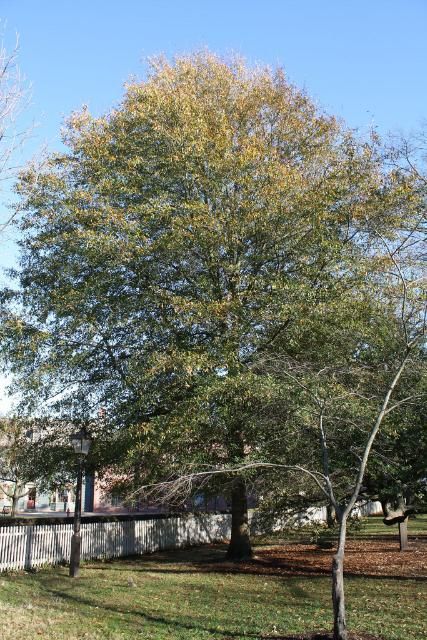Family
Fagaceae, beech and oak family.
Genus
Quercus comes from the Latin name for "oak" and is formed from two Celtic words: quer meaning "beautiful" and cuez meaning "tree."
Species
The species name hemisphaerica stems from the Greek words hemi meaning "half" and sphaer meaning "a ball" or "globular."
Common Names
Darlington Oak, Laurel Oak
The common name "laurel oak" can be confusing because Quercus laurifolia also goes by the same name. In the past, these two trees were considered to be the same species. However, Quercus laurifolia is also known as diamond-leaf oak, which refers to the shape of its leaves. This feature along with their differing preferred habitats helps to distinguish these two oaks from one another. Quercus laurifolia is generally found on wet sites and Quercus hemisphaerica on more upland sites.
Description
This tardily deciduous and relatively short-lived native tree (it reaches maturity at approximately 50 years and lives for 70–90 years) is found along sandy ridges and mixed forests from Virginia south to Florida and west to Texas. It grows best in partial to full sun and can reach heights of up to 100 feet. The thin but leathery-textured leaves are simple and alternate, and 1 to 5 inches long. The leaves are narrowly elliptic or lanceolate with smooth margins or edges and generally exhibit a pointed tip (that often falls off late in the season). The top side of the leaf is dark green and the underside is bright green. The bark is gray and mostly smooth when immature, becoming more rigid and furrowed (more deeply grooved) with maturity. Acorns are small (just one centimeter long) with a grayish cup that covers about 1/3 of the dark brown nut, and the acorns mature in two years.

Credit: Homer Edward Price, CC BY 2.0
Allergen
All members of this genus produce large amounts of pollen, making both deciduous and evergreen oaks highly to extremely allergenic.
Applications
Commercial/Practical
While Darlington oak has limited commercial value, it is commonly used as firewood and pulpwood, and for large drag mats or other heavy-use timbers.
Horticultural
This fast-growing tree can reach heights of up to 100 feet, making it a great year-round shade tree that has a denser canopy in the spring and summer months. However, care should be taken when planting this tree near a house because the life span of Darlington oak is only 50 years, becoming susceptible to disease and rot with maturity. Like all other oaks, the leaves and acorns of this tree have a high tannin content that can stain concrete. If this is undesirable, homeowners and others should consider this attribute when deciding where to plant this tree.

Credit: Phillip Merritt, CC BY-NC-SA 2.0
Wildlife
The Darlington oak is a great food source for many species of wildlife, especially because it regularly produces abundant amounts of acorns.
References
Austin, D. F. 2004. Florida ethnobotany. Boca Raton, FL: CRC Press.
Borror, D. J. 1988. Dictionary of root words and combining forms (1st ed.). Mountain View, CA: Mayfield Publishing Company.
Gledhill, D. 1989. The names of plants (2nd ed.). Cambridge: Press Syndicate of the University of Cambridge.
Godfrey, R. K. 1988. Trees, shrubs, and woody vines of Northern Florida and adjacent Georgia and Alabama. Athens, GA: The University of Georgia Press.
Kurz, H. and R. K. Godfrey. 1993. Trees of Northern Florida. Gainesville, FL: University Press of Florida.
Nelson, G. 1994. The trees of Florida: A reference and field guide. Sarasota, FL: Pineapple Press.
Ogren, T. L. 2000. Allergy-free gardening: The revolutionary guide to healthy landscaping. Berkeley, CA: Ten Speed Press.
Stein, J., D. Binion, and R. Acciavatti. 2003. Field guide to native oak species of Eastern North America. Morgantown, WV: USDA Forest Service.